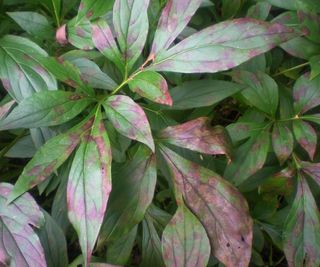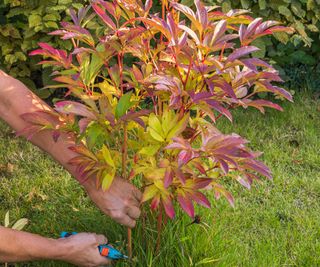With their sweet fragrance and impressive bloom, it is easy to understand why peonies are such a popular choice for the home landscape. Though their flowering period is limited, from spring to early summer, gardeners can expect continued beauty throughout the season. Thick, glossy foliage grows to form dense shrubs, and only a little peony care is needed in order to thrive.
Some tasks, however, should not be ignored. This includes pruning, or cutting back plants, in preparation for winter. This guide aims to discuss how and when to cut back peonies, with a special focus on herbaceous types, so as to ensure their return season after season.
(Image credit: Ivan4ES / Getty Images)
Why You Need to Cut Back Peonies
To better understand when to cut back peonies for winter, growers should first consider the rationale behind the process. Though peony shrubs can be trimmed periodically throughout summer to remove diseased or damaged stems, all foliage should be left in the garden as long as possible.
During this time, plants will continue to absorb light and convert it into much-needed energy, to be used the following season. This stored energy will aid in the growth and development of shrubs in spring, and their overall production of flowers. Although peony pruning is eventually important to long-term health, cutting too soon will rob plants of vital nutrients, often resulting in poor performance.
So if you are worried about when to cut back peony plants, take your time. Proper removal of foliage will also play a major role in garden health. The clipping and removal of all decaying plant matter will greatly help to prevent the spread of disease and their recurrence the following season.
When to Cut Back Peonies
There’s little doubt that cutting back shrubs can be beneficial, but when should you cut back peonies? In most instances, when to cut back peony bushes will be determined by the weather. Plants will begin to yellow and die back to the ground in fall. This should occur naturally and generally coincides with the first hard frost of the season. It is at this time that gardeners can begin to safely cut back the plants.
It is not uncommon for peonies to become messy or look unkempt in late summer. Growers hoping to tidy these beds can make use of light trimming or deadheading peonies to help improve their overall appearance.

(Image credit: Valentina Sheboltaeva / Getty Images)
Cutting Back To Control Disease
As noted, cutting back peonies in fall is essential to the control of disease. Infections like botrytis and powdery mildew are most common, each surviving winter amid infected foliage. By cutting and removing all plant matter from the garden, the spread of peony diseases can be prevented.
Treatment of plants and soil with fungicide can further help to control disease, with these growers opting to take a more proactive approach. So in deciding when to cut back peonies, keep a close eye on the overall health of the plant – especially the foliage – because this might turn out to be just as important as seasonality.
Trimming Different Peonies
To this point, we have exclusively discussed the needs of herbaceous peony species. However, care in terms of pruning will vary between different types of peony shrub. How and when to cut back Itoh peonies, for example, will differ. The same can be said of tree peonies, which require very little pruning, if any.
Familiarizing oneself with each peony variety to be grown in your garden will be essential to their overall care. Knowledge is power if you want to be certain that plants are healthy and happy for years to come.

(Image credit: Mulevich / Shutterstock)
Frequently Asked Questions
Can You Cut Back Peonies Too Much?
Trimming or pruning should always be kept to a minimum during periods of active growth. Though herbaceous peonies will benefit greatly from cutting in fall, other types will require much more care. Excess cutting can be especially detrimental to the health of Itoh peonies and tree peony species.
Can I Cut Back Peonies in the Spring?
Peony plants should be cut back in fall, after the first frost. At this time, stems will have died back naturally. Should growers forget to cut back their plants, dead and decaying foliage can be removed in spring. This should be done before new growth has emerged, with gardeners making certain to avoid damage to roots or developing growth tips.




